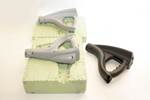Mold Design Using Air Jets Solves Molding Challenges
An easy air de-molding process has been developed for de-molding flexible parts with large undercuts by using air jets.
An easy air de-molding process has been developed for de-molding flexible parts with large undercuts by using air jets—which will allow higher flexibility in designing molds and achieve higher reliability in products due to its simple structure.
This process—developed by MD Pro Technos Corp. (Torrance, CA)—a plastic injection moldmaker for the automotive, consumer electronics and medical industries—
addresses end products that use softer resins like elastomer, which are often used for caps for medical, pharmaceutical containers, etc.
According to MD Pro Technos President Shinichi Shimada, these products typically have undercuts around the whole circumference of the inside diameter that may tend to change shape when de-molded using typical ejectors or strippers. “Typically, de-molding of undercuts using ordinary molds is a two-way process,” Shimada explains. “First, the core of the mold moves to expand the undercut parts. Then, the product is removed using a stripper.
“Deterioration of mold accuracy in products by this deforming limits the ranges of the products’ use and application,” Shimada continues. “The process was developed in order to prevent this from occurring. To make this possible, the balance and timing of the air jets’ spray position and volume must be controlled—which is difficult.”
A New Method
This new de-molding process uses air to expand the parts at the same time the parts are being ejected. This expands the undercuts and makes it possible to de-mold smoothly, without deformation or parting lines. The process begins with mold design. “When a mold with large undercuts is designed, we account for the use of air jets in the mold design,” Shimada notes. “During mold set-up, the air jets need to be balanced. The molds are designed and machined in a different manner—outlined below—to account for the use of air jets, as compared with other molds for similar parts.”
With the new air jet process, there is an additional “core” installed insid6e of the moving core. Small holes for the air jets are installed in the new core—resulting in a simpler structure with less complication and moving parts. Shimada says that the number of holes, position and air volume is different product by product, and thus designed separately for each product. Finally the core—which blows air—also functions as a valve.
Shimada notes that this process offers the following advantages:
- Simple mold structure, which enables a smaller mold size and reduces mechanical problems and requires less maintenance.
- Much less deformation allows for easier accuracy control.
- Produces high precision products without producing lines (burr) on the product surface.
This technology works best with smaller molds, according to Shimada. There is a size limitation up to around 1.5 mm (undercut size) for undercuts around whole circumference of the inside diameter. And, it can only be used on elastic materials such as elastomer.
Shimada explains that this technology should be used on molds that are small and difficult to secure enough space for ordinary slides, etc., and prohibit producing lines (burrs). Using this technology, he concludes, can reduce mold adjustment time by about 30 percent.
Related Content
-
Large Hybrid Steel Insert Solves Deformation, Dimensionality, Cycle Time Problems
DMLS printers using metal additive powders selected by Linear AMS to produce high-quality, accurate, consistent 3D-printed mold components with certification and traceability.
-
In "Hybrid" FIM Process, 3D Printing Complements Injection Molding
Alpine Advanced Materials used a desktop 3D printer and the freeform injection molding process to reduce prototype tooling production time and cost for its customers.
-
Five-Axis Graphite Mill With Automation Debottlenecks Electrode Machining
Five-axis electrode cutting enabled Preferred Tool to EDM complex internal screw geometry on an insert that otherwise would have had to be outsourced.











